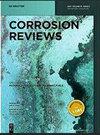用氧化石墨烯和聚苯胺改性有机硅丙烯酸树脂的新型防腐涂料
IF 3.2
4区 材料科学
Q3 ELECTROCHEMISTRY
引用次数: 0
摘要
摘要金属表面涂层是一种方便、低成本的防腐问题,而相应的耐热性和耐腐蚀性差等缺陷也明显阻碍了其进一步应用。因此,不断开发新型高效涂料对提高金属的防腐性能具有重要意义。本研究采用氧化石墨烯(GO)的二维层状结构,通过直接共混的方式对硅丙树脂进行改性,以提高其耐腐蚀性。然后,采用原位聚合法制备了聚苯胺/氧化石墨烯(PANI/GO)复合材料,创新性地实现了片状和纤维状材料的结合,填补了涂层固化成膜时产生的空隙,提高了涂层的密度和防腐性能。结果表明,PANI/GO改性的涂层具有较好的热稳定性,其T5%和Tmax分别提高了44和5°C。采用电化学阻抗谱(EIS)和Tafel极化曲线分析了改性涂层在3.5wt%NaCl水溶液中的防腐性能。PANI/GO中含有20wt%GO的涂层具有最佳的耐腐蚀性,浸渍60天后的腐蚀电位为−0.14(V vs.Hg/Hg2Cl2),腐蚀电流密度为1.8×10−11 A cm−2,极化电阻为6.06×1010Ωcm2,腐蚀速率较低,为4.18×10−7 mm year−1。本文章由计算机程序翻译,如有差异,请以英文原文为准。
Novel anticorrosive coating of silicone acrylic resin modified by graphene oxide and polyaniline
Abstract Coatings of metal surfaces is a convenient and low cost anti-corrosion issue, while corresponding defects like poor heat and corrosion resistance are also obviously hinder its further application. Hence, continuously developing new and efficient coatings is of great significance to improve anti-corrosion for metals. In this study, silicone-acrylic resin was modified by two-dimensional lamellar structure of graphene oxide (GO) though direct co-blending to improve the anti-corrosion. Then, polyaniline/graphene oxide (PANI/GO) composites was prepared by in-situ polymerization method, which innovatively achieved the combination of flake and fibrous materials to fill the voids generated when the coating is cured into a film, and enhance the density and the anti-corrosion performance of the coating. The result showed that the coating modified by PANI/GO had the better thermal stability, which T5% and Tmax are increased by 44 and 5 °C, respectively. Electrochemical impedance spectroscopy (EIS) and Tafel polarization curves were employed to analyze anticorrosion performance of modified coatings explored in 3.5 wt% NaCl aqueous solution. The coating with 20 wt% GO in PANI/GO has the best corrosion resistance with corrosion potential of −0.14 (V vs. Hg/Hg2Cl2), corrosion current density of 1.8 × 10−11 A cm−2, polarization resistance of 6.06 × 1010 Ω cm2, and lower corrosion rate of 4.18 × 10−7 mm year−1 after immersion for 60 day.
求助全文
通过发布文献求助,成功后即可免费获取论文全文。
去求助
来源期刊

Corrosion Reviews
工程技术-材料科学:膜
CiteScore
5.20
自引率
3.10%
发文量
44
审稿时长
4.5 months
期刊介绍:
Corrosion Reviews is an international bimonthly journal devoted to critical reviews and, to a lesser extent, outstanding original articles that are key to advancing the understanding and application of corrosion science and engineering in the service of society. Papers may be of a theoretical, experimental or practical nature, provided that they make a significant contribution to knowledge in the field.
 求助内容:
求助内容: 应助结果提醒方式:
应助结果提醒方式:


